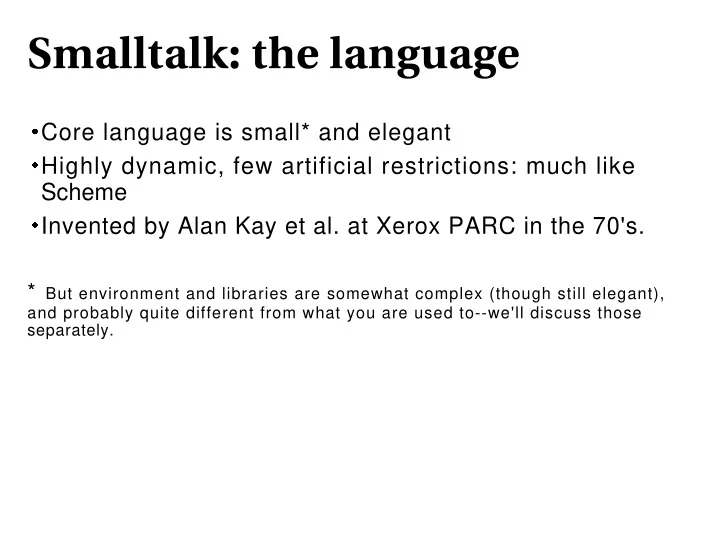

Core language is small* and elegant Highly dynamic, few artificial restrictions: much like Scheme Invented by Alan Kay et al. at Xerox PARC in the 70's. * But environment and libraries are somewhat complex (though still elegant), and probably quite different from what you are used to--we'll discuss those separately.
Variable bindings: x := 'hi'. Variable bindings are mutable: x := 28. x := 54. changes the original binding unlike ML more like Scheme's define special form Note that Smalltalk is dynamically typed
Everything is an object Objects communicate via messages " Message send " = " virtual function call " Message types: x negated. "Unary message syntax" x + 5. "Binary message syntax" x gcd: 21. "Keyword message syntax" Keyword message with multiple arguments: 'Hello, world' replaceFrom: 1 to: 6 with: 'byebye' startingAt: 1.
Periods separate statements; semicolons separate messages sent to the same receiver. 2 + 5; negated. "Evaluates 2 + 5, then 2 negated." Strings are single quoted; comments are double quoted. 'This is a string'. "This is a comment" All binary messages associate left to right . Normal arithmetic precedence rules don't apply. 2 + 3 * 4 "Evaluates to 20."
Smalltalk has lexically scoped anonymous functions (a.k.a. lambdas/closures). Lambdas are objects, so they are evaluated by sending one of the value messages. "Smalltalk" (* Rough ML equiv. *) [ 3 ]. fn () => 3; [ 3 ] value. (fn () => 3)(); [ :x :y | x + y ]. fn (x, y) => x + y; a := [ :x :y | x + y ]. val a = fn (x, y) => x + y; a value: 1 value: 2. a(1, 2);
Closures are lexically scoped However, they may have arbitrary side effects, including the effect of changing bindings in enclosing environments: i := 5. "i gets 5" [ i := 7 ] value. "i in outer scope gets 7" [ :i | i := 9 ] value: 2. "i gets 2, then 9 in local scope;" "i remains 7 in outer scope"
ML and Scheme have both closures and special forms like if/then/else for control structures Smalltalk uses closures to implement control structures Transcript open. "Open a Transcript window" 5 timesRepeat: [ Transcript show: 'hi'; cr. ]. x = 0 ifTrue: [ Transcript show: 'Cannot divide by zero' ] ifFalse: [ Transcript show: (1.0 / x) asString. ]. i := 0. [ i < 10 ] whileTrue: [ i := i + 1. ].
Closures with many arguments are evaluated using up to 4 value: keywords: seal := [ :a :b :c :d | a + b * c + d ]. seal value: 1 value: 2 value: 3 value: 4. Longer argument lists use valueWithArguments:, which takes an array: walrus := [ :a :b :c :d :e | a + b * c + d * e ]. walrus valueWithArguments: #( 10 20 30 40 50 ). "Note #() syntax for arrays"
Smalltalk has no access protection for methods. However, all member variables are accessible only to the owning instance. Classes inherit superclass instance variables, and can access them.. In C++ terminology All methods are public. All member variables are protected, except that you cannot access member variables of other objects of the same class, as in C++. Ownership is "instance-based", not "class-based".
Everything is an object. Every object has a class. Classes are objects. So, what is the class of a class? "Smalltalk expression" Result of printIt x := 3. 3 x class. SmallInteger x class class. SmallInteger class x class class class. Metaclass x class class class class. Metaclass class x class class class class class. Metaclass x class class class class class class. Metaclass class
Recommend
More recommend